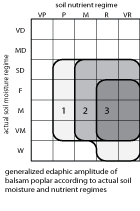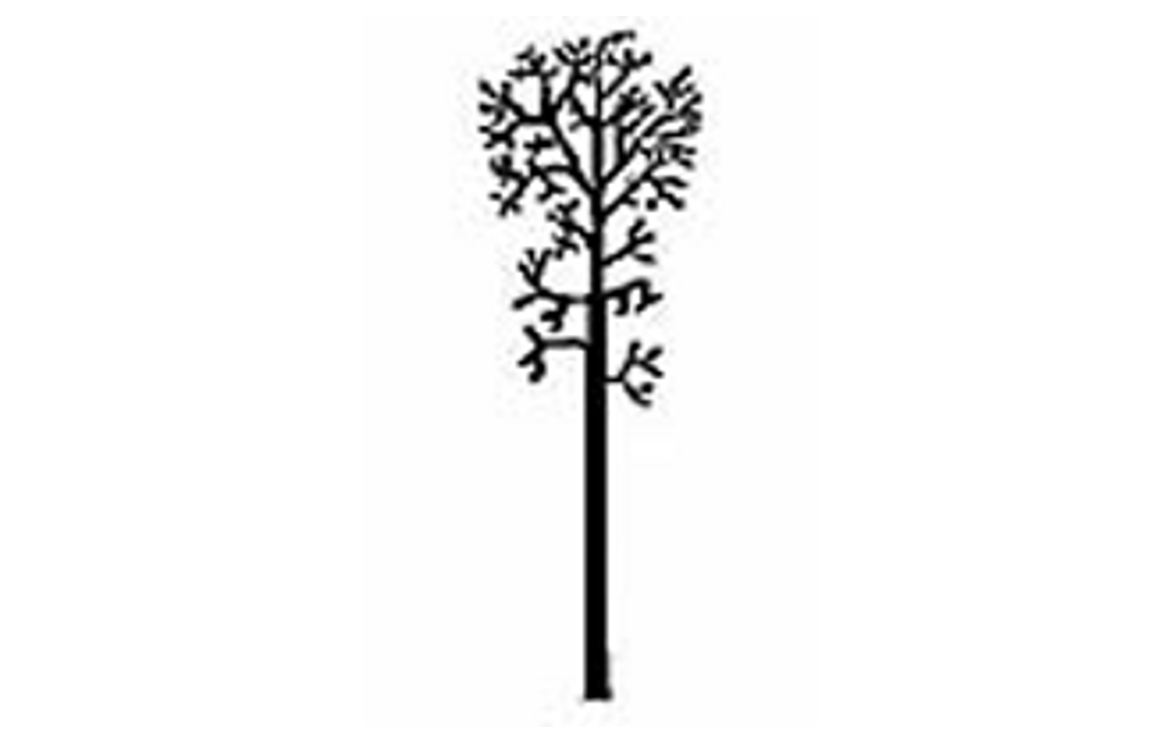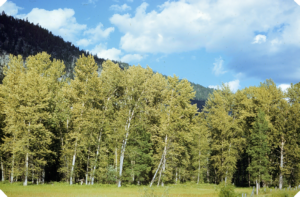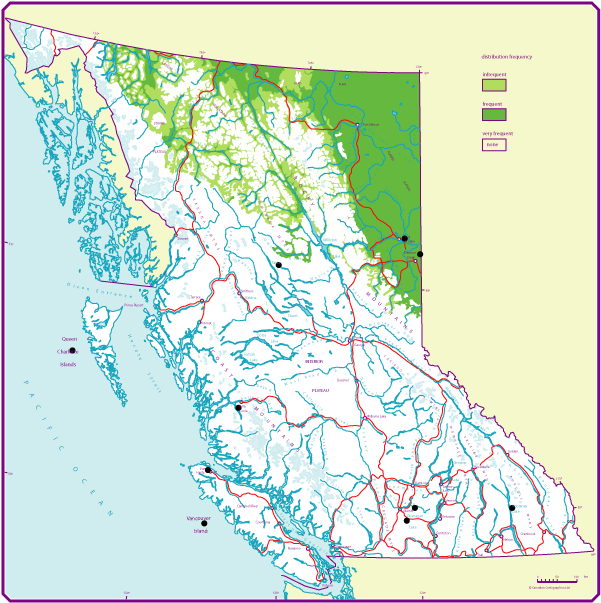Balsam poplar
Balsam poplar (Acb) - Populus balsamifera
Balsam poplar is a medium-sized (exceptionally over 30m tall), deciduous broad-leaved tree, at maturity with a narrow, open crown of thick ascending branches and gray and deeply furrowed bark. Many kinds of wildlife use the twigs for food. The light, soft wood is used for pulp and construction.
On this page
- Geographic range and ecological amplitudes
- Tolerances and damaging agents
- Silvical characteristics
- Genetics and notes
Geographic range and ecological amplitudes
Geographic range
Geographic element:
North American transcontinental-incomplete
Distribution in Western North America:
north in the Pacific region; north and central in the Cordilleran region
Ecological amplitudes
Climatic amplitude:
subarctic - subalpine boreal - montane boreal - cool temperate
Orographic amplitude:
submontane - montane - subalpine
Occurrence in biogeoclimatic zones:
(lower SWB), BWBS, (SBS), (IDF), (ICH)
Edaphic amplitude

Range of soil moisture regimes:
slightly dry - fresh - moist - very moist - (wet)
Range of soil nutrient regimes:
(poor) - medium - rich - very rich
Balsam poplar does not tolerate acid Mor humus forms because it requires a good supply of nitrate nitrogen, calcium, and magnesium. Therefore, it benefits from soils in which these nutrients are replenished by flooding in spring or before summer. As with black cottonwood, balsam poplar does not tolerate brackish water.
Tolerances and damaging agents
Root System Characteristics
On floodplains, the root system of balsam poplar is multi-layered, owing to the deposition of new soil by periodic flooding. Although early root development is downward, subsequent development progresses upward as root growth occurs on the buried stem. Lateral root spread can be >14m. Roots are associated with ecto- and endo-mycorrhizae.
| Tolerance to | Tolerance class | Comments |
|---|---|---|
| low light | L | a very intolerant, exposure-requiring species |
| frost | H | it may grow in permafrost soils |
| heat | M | not a concern in boreal climates |
| water deficit | L | absent on water deficient sites |
| water surplus | H | tolerates flooding and strongly fluctuating water table well; intolerant of brackish water |
| nutrient (mainly N) deficiency | L | absent on very poor sites, infrequent on poor sites |
| Damaging agent | Resistance class | Comments |
|---|---|---|
| snow | M | |
| wind | H | high winds will break the boles rather than uproot trees |
| Risk class | ||
|---|---|---|
| fire | L | not a concern in pure balsam poplar stands |
| insect | L | not a major concern; wood borers (for example, poplar borer) |
| fungi | L | not a major concern; heart rots (for example, aspen trunk rot) |
| other agents | L | not a major concern; browsing by large ungulates |
Associated tree species and successional role
In British Columbia, balsam poplar grows predominantly in even-aged, pure stands, and, in the later stages of primary succession on floodplains, with shade-tolerant conifers. The most commonly associated tree species are subalpine fir and white spruce (and its hybrids). Balsam poplar is a pioneer species (primary succession) on floodplains, and is present in early and intermediate stages of secondary succession on floodplains and upland sites.
Genetics and notes
Genetics
Two varieties have been identified: var. balsamifera and var. subcordata. Balsam poplar and black cottonwood hybridize and produce mixed populations fairly frequently where both taxa are sympatric, or even when they are separated by rather large distances, because it is wind-pollinated and its pollen grains may be easily transported a long distance. Interbreeding may be seen as intraspecific, providing we consider, as it is often done, that both taxa belong to the same species; the scientific name in this case is Populus balsamifera L. s.l.
Notes
Balsam poplar produces in a short time high yields of wood suitable for mechanical pulping. Considering its productivity, vegetative reproduction, and low risk of being affected by damaging agents, it is a suitable species for intensive management on flooded sites. More detailed silvics information is given by:
Peterson, E.B. and N.M. Peterson. 1992. Ecology, management, and use of aspen and balsam poplar in the prairie provinces. Special Report 1, For. Can., Northern Forestry Centre, Edmonton, Alberta. 252 pp.
Zasada, J.S. and H.N. Phipps. 1990. Populus balsamifera. Pp. 518-529 in R.M. Burns and B.H. Honkala (technical coordinators) Silvics of North America, Vol. 2. Agri. Handbook 654, USDA For. Serv., Washington, D.C.

This is the general shape and outline of the balsam poplar.

Old-growth balsam poplar on an alluvial terrace west of Fort St. John. Poplars inhabit low and medium bench sites along major streams, which are typically fresh to moist and nutrient-rich to very rich.

